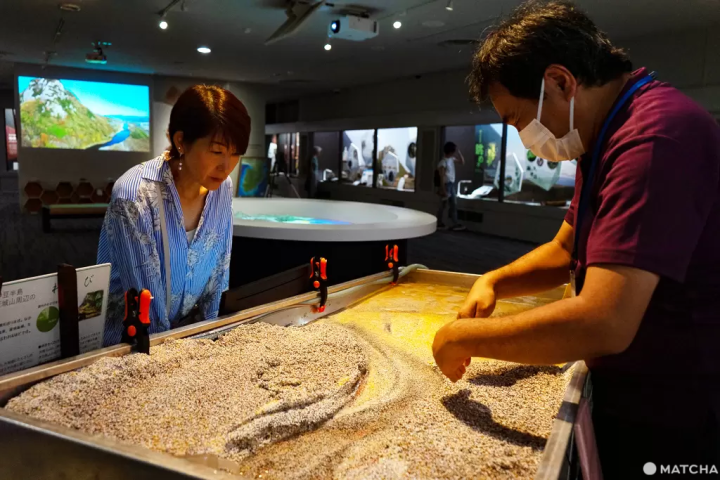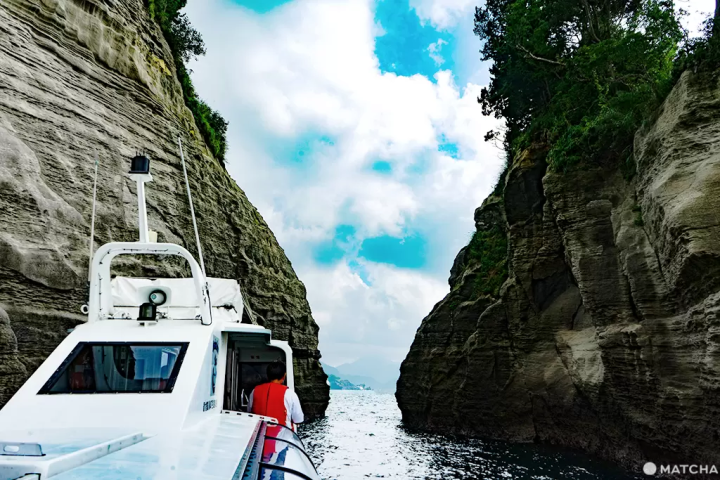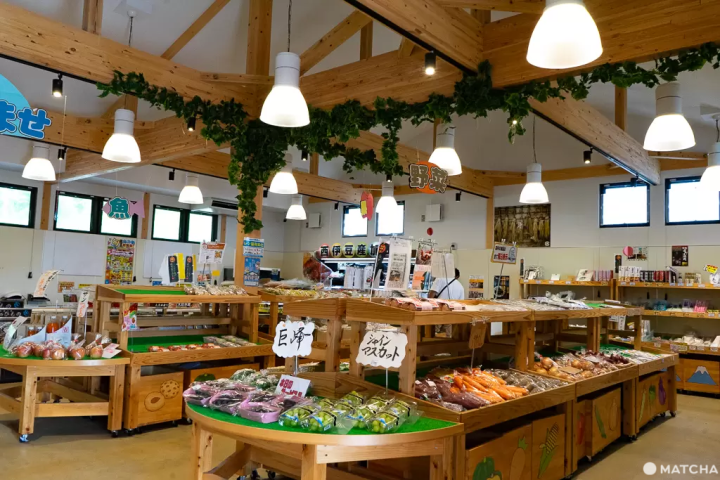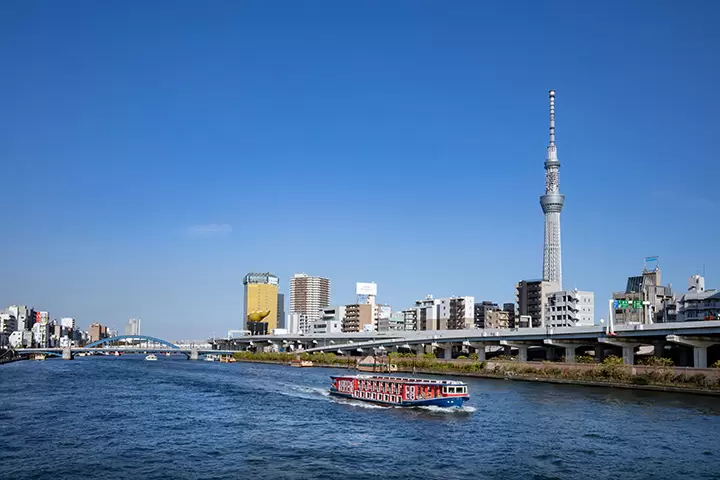Izu Peninsula: Two-Day Trip Featuring Local Culture and Cuisine

Shizuoka―home to Mt. Fuji and Suruga Bay―has a rich food culture. This article features a two-day tour of the local nature and cuisine. We'll explore the Geopark Museum and Blue Cave, enjoy tasty gourmet, and go glamping at Wasabi Village.
Shizuoka: Abundant Nature and a Rich Food Culture
Shizuoka Prefecture―known for the world-famous Mt. Fuji and Suruga Bay (the deepest bay in Japan)―is home to a rich food culture. This article introduces a two-day travel plan that features Shizuoka's local gourmet specialties.
We'll go on a tour of the Izu Peninsula with its unique topography and Dogashima Tensodo Cave, also known as the Blue Cave. We'll also visit a wasabi farm deep in the mountains that uses the "Tatamiishi style" of cultivation—even recognized as a Globally Important Agricultural Heritage Systems (GIAHS).
Additionally, this trip allows visitors to enjoy the nature and cuisine of the Izu Peninsula and Shizuoka Prefecture. This includes tasting local food in a historic Japanese mansion and learning about the history of shiokatsuo (salted bonito), one of many local specialties.
Georia: Is the Izu Peninsula a Gift from a Volcano?

Georia Izu Geopark Museum is near the famous sightseeing spot, Shuzenji Temple. Visitors will learn about the Izu Peninsula's unique geology alongside the climate and culture that this place has nurtured. There's also a feature on the local food culture. Admission is free for all museum-goers.

Presentations at the museum theater―in Japanese, English, simplified Chinese, traditional Chinese, and Korean―explain how the Izu Peninsula originally formed.
About two million years ago, the Japanese archipelago was created by oceanic plate movement. At the time, Izu was a series of submarine volcanoes (volcanoes beneath the ocean's surface). Then, roughly one million years ago, they collided with the Japanese archipelago. After many years, it took its current shape, caused by movements in the earth's crust.
Through images projected onto a model of the Izu Peninsula, you can also learn about the spectacular scenery, history, culture, and food of each season.

The museum guide will explain the mysteries of Izu's mineral resources and rocks. Visitors can also see a water model that simulates the process when a river changes its course and becomes fan-shaped.
With a deeper understanding of Izu's geology, the more you'll be able to appreciate the peninsula's uniqueness. The Izu Peninsula was, in fact, officially certified as a UNESCO Global Geopark in 2018.
Dogashima Tensodo Cave: A Blue Cave on Nishi-Izu's Coastline

In Izu Peninsula's western region (Nishi-Izu), many secluded spots were created by the upward-lifting movements of submarine volcanoes.
By hopping on a pleasure boat, you can see a variety of diverse terrain and geology.
This includes special striped strata layers created by accumulated volcanic ash, pumice stone, and other materials ejected during volcanic eruptions. There are also columnar joints and volcanic necks that formed when the volcanic magma cooled down and hardened.

Passengers can enjoy learning about the earth's eternal history while listening to the guide's commentary.
Highlights include Turtle Island (Kame Iwa), a rock formation resembling a turtle about to climb onto land. There's also Snake Island (Hebi Iwa), where a rock became a stratum with snake-like patterns when a debris flow destroyed a layer of volcanic ash deposited on the ocean floor.

Especially famous here is the Dogashima Tensodo Cave. The cave was created when soft, porous rock (volcanic tuff) formed by ash ejected during a volcanic eruption was gradually eroded by waves. The cave's central area is circular and looks like a skylight.
When sunlight passes through here, the water shimmers with a mystical blue color.
Lunch: Takeru Quindici LOQUAT Nishi-Izu

LOQUAT Nishi-Izu operates out of a renovated 300-year-old mansion that formerly belonged to a distinguished local family, the Suzuki clan. Guests can admire the lush green scenery while relaxing in this open and comfortable space.
This is both a restaurant and an accommodation facility. On the premises, you'll find the Italian restaurant Takeru Quindici, a bakery, an ice cream shop, and a hotel offering stays for up to three guest parties per night.

The restaurant serves fresh, local ingredients sourced daily so that visitors can savor the superb taste of Nishi-Izu.
The menu changes daily. On our visit, we had the set lunch, which consisted of a salad, appetizers, a choice of two kinds of pasta, the main dish, and dessert.
There was horse mackerel, mackerel, and other fresh seafood, along with top-quality meat and refined dishes that were smoked and boiled. A colorful array of starters made with sweet and flavorful local vegetables also made their way to the table.
Two pasta dishes―one with salted pork and young sardines and the other with beef―came with a sauce that enhanced the taste of the ingredients, allowing us to enjoy the flavors of each season.

For the main dish, diners have a choice of two different entrees.
On this occasion, we chose a dish using Shizuoka's famous pork, Fujinokuni. This refined dish comes garnished with multi-colored roasted vegetables. The pork's flavor and the vegetables' richness go perfectly with the chef's homemade sauce.

According to Chef Tomite, the Izu farm where the ingredients are sourced is near the ocean. The salt in the gentle breeze from the sea apparently helps to bring out the true flavor of the vegetables.

For dessert, you can choose from three tasty selections: tiramisu, strawberry semifreddo, and salted cream pudding. With these unexpected combinations, you can enjoy a flavor that's slightly different from the norm.
*The menu can sometimes change depending on the season.
Read also
Hanbata Market: See the Bounty From Nishi-Izu's Sea and Mountains

The "hanbata" in Hanbata Market means "at the seashore" in the Izu Japanese dialect.
Hanbata Market features products direct from the farm, bringing growers and consumers together in one spot. Here they sell fresh local vegetables and seafood.
Inside the market, there's a large water tank filled with many fish. Here you'll discover a wide variety of fish and shellfish that can't be found anywhere else. In addition to the fresh food products, you can also enjoy local gourmet specialties unique to Nishi-Izu.
Fujii Wasabi Garden: Organic Wasabi Grown Deep in the Mountains of Shizuoka

The birthplace of wasabi cultivation is Utogi in Shizuoka Prefecture's Aoi Ward.
Wasabi cultivation methods were introduced to Izu during the mid-18th century. In particular, one method known as "Tatamiishi" was developed here. Presently, much of the wasabi in Shizuoka Prefecture utilizes this method.
Wasabi can only grow in an environment with heavy rainfall and spring water. Shizuoka's water wasabi cultivation areas, built upon its abundant water resources combined with the wisdom of the locals, were designated as part of the Globally Important Agricultural Heritage Systems.

On this day, we visited Fujii Wasabi Garden.
The garden's owner Mr. Fujii, who previously worked for a leading beverage company, recounted how he couldn't forget the experience of growing up in nature when he was young. After hearing about a wasabi farm deep in the mountains of Nishi-Izu that had been abandoned for some 20 years, he went ahead and revived it.
Fujii Wasabi Garden sits in a highly favorable location. It's blessed with spring water from nearby Mt. Amagi. The area also has an average annual temperature of 14°C.
However, the efforts of Mr. and Mrs. Fujii have played a big role in the successful cultivation of this pesticide-free wasabi. They've often found themselves exterminating insects, day and night, and raking up countless fallen leaves.
Dancing butterflies and fireflies can also be spotted on summer nights in this wasabi garden.

It takes about one year to grow wasabi at Fujii Wasabi Garden. At harvest time, force is used to pull out the wasabi roots after utilizing a tool for digging up the nearby soil. This labor-intensive work ensures high-quality wasabi.
Accommodation: A Secret Basecamp for Adults Called Wasabi Village

Down below Fujii Wasabi Garden is where the Wasabi Village is located. This is a glamping accommodation facility also managed by the Fujii family. These five Salem Travel Trailers were brought directly over from America to create this "secret basecamp for adults."

Wasabi Village has a limit of four guest parties per day, and one travel trailer can accommodate up to six people.
From the private wooden veranda, guests can enjoy the sound of birds chirping early in the morning and the mystical sight of starry skies at night. The nearby waters are pure and clean, so mosquitos are not an issue.

Each travel trailer features a living area with a large-screen TV, a kitchen equipped with cooking utensils, and two guest rooms with a heating-air conditioner unit. Baths and toilets have been renovated, ensuring a relaxed and comfortable stay inside your trailer.

Also, don't forget to enjoy the wood-burning bath located outside―imported directly from Sweden!
As you soak in the tub, the firewood-heated warm mountain water will soothe your tired body. While listening to the soft murmur of a local stream, your body and soul will be able to relax and refresh.
Dinner: A BBQ Dinner Featuring the Bounty of Sea and Mountains

We'll be using Wasabi Village's BBQ equipment for dinner, which was imported from the United States. In addition to enjoying local vegetables, seafood and other food products from the Hanbata Market, guests can taste wild game meat from a company called HOLY.

HOLY offers deer (venison), wild boar (inoshishi), and other game meats that were hunted in the local mountains.
The staff, with over 20 year's experience in Italy and at the overseas Japanese embassy, are in charge of the meat processing. The meat is then marinated with local ingredients, resulting in a delicious taste!
The Sakuraba Pork Pickled in Miso, the Venison Pickled in Citrus Fruits, and other game meats that we sampled were all tender and juicy with no strong odor. These dishes are great with a draft beer!

Guests who stay here also receive a complimentary organic wasabi gift from Fujii Wasabi Garden. Freshly grated wasabi has a great fragrance, a spicy bite combined with some sweetness, and enhances the flavor of food.
By spreading Fujii Wasabi Garden's homemade wasabi miso paste on some vegetables, you can enjoy a taste sensation that's a little different from usual condiments.
Also, Mr. Fujii apparently loves to drink shochu (Japanese distilled spirits) with some homegrown wasabi added to it!
Hands-on Woodworking Experience to Learn about the Local Forest

At Wasabi Village, visitors can make a wooden accessory or tray using cedar and other wood from the Izu region alongside Mr. and Mrs. Ishizaki from Forest Design.

The Ishizakis will be right by your side to guide you. Even beginners can easily make their desired piece of art.
Shiokatsuo: Nishi-Izu's Local Gourmet Specialty

The most important component in Japanese cuisine is the making of dashi soup stock. Bonito flakes―created by smoking bonito fish―are the basis of this process.
Kanesa Katsuobushi Store, founded in Nishi-Izu in 1882, is known for its umami-rich katsuobushi-related products. They use a method called Tebiyamashiki Baikan Hoho, where the quantity of heat used during the production process is manually regulated.
This method has a long-spanning history. However, the process is time-consuming and said to be inefficient and dangerous. Even in Japan, few companies use this method. It can, therefore, be considered a precious technology that's been preserved to this day.

Izu Tago Port is one of three main katsuobushi production areas. You'll find a specialty called shiokatsuo―considered a lucky charm since ancient times.
Shiokatsuo is bonito fish that's been salted and dried. In addition to being a preserved food, it's decorated with sacred ropes and displayed during the New Year. It has also been offered to Shinto altars to pray for safe navigation and a bountiful harvest.
However, shiokatsuo has a high salt content. So with the development of seasonings, regular bonito flakes became the mainstay as a normal preserved food. Nowadays, the custom of eating shiokatsuo only remains in the Izu region.

With technological advances in product commercialization, shiokatsuo using the entire fish is now more readily available than before. At Kanesa, they also sell a wide variety of products including katsuobushi and shiokatsuo-related seasonings.
Koganezaki Park: Savor Shiokatsuo Udon at This Mecca for Animation!

The Koganezaki Nishi-Izu Visitor Center is located inside Koganezaki Park. They offer a cozy rest-cafe space highlighted with wooden accents. It's also become a mecca for fans of the popular animation series "Yurucamp (Laid-Back Camp)."

In addition to an exhibit featuring a history of Koganezaki's topography, visitors can enjoy snacks and beverages on the premises.
Plus, you can sample Nishi-Izu's famous specialty: Shiokatsuo Udon. The smooth udon noodles have the concentrated flavor of bonito, and offer a simple, delicious taste.

According to our topographical guide, Koganezaki was also formed by submarine volcanic activity some one million years ago.
Due to the influence of the magma underneath the earth's surface, the hot underground water that spewed out during volcanic eruptions caused a chemical reaction to take place with the surrounding rocks. This in turn created the present-day Izu coastline.
When the sun's rays hit these nearby rock formations, they glow with an impressive gold color (Koganezaki means "golden cliff" in English).
From Suruga Bay, you can see Mt. Fuji in the distance. Horse Rock, listed as one of Japan's 100 Oddly Shaped Rocks, is a natural formation created by erosion (see photo above).
Prefectural Road 223: A Sea Route Crossing Suruga Bay

Prefectural Road 223 was created in 2013. It's a unique route that can also be read as "Fujisan" in Japanese. Additionally, it's been certified as the sixth maritime prefectural route in Japan.

This route is officially called Shizuoka Prefectural Road 223 Shimizu Bay-Toi Line. This sea route connects Shizuoka City's Shimizu Port with Izu City's Toi Port. Ferries depart from Suruga Bay and reach Shimizu Port in about one hour and five minutes.
On days of good weather, you get an all-encompassing view of Mt. Fuji. It's also possible to encounter dolphins and whales along the way.

Ferries also offer top-class special private seats. You can ask the guide to explain the origin and history of Suruga Bay. Don't hesitate to ask about the abundant seafood that's only found in Japan's deepest bay.

You can take a commemorative photo on the outdoor deck. We also recommend picking up a Prefectural Road 223 souvenir!
The Izu Peninsula Is a Food Lover's Paradise!
On the Izu Peninsula, the region's topography, history, and cultural diversity are all reflected in the local food. As a result, it's often referred to as a paradise for gourmet food lovers.
While learning about Izu's climate and history from a local guide, please enjoy a trip filled with unforgettable cuisine!
Written by Lin
Sponsored by Shizuoka Gastronomy Tourism
MATCHA's promotional account for corporate and local government advertising. We aim to provide useful information to our readers in an enjoyable manner.








































![[Just a short distance from Nagoya] Popular Taiwanese YouTuber Alan tours Aichi, Tokoname!](https://resources.matcha-jp.com/resize/720x2000/2026/01/08-255181.webp)